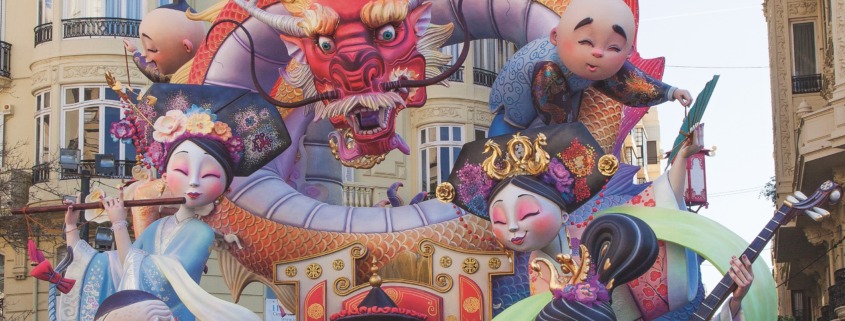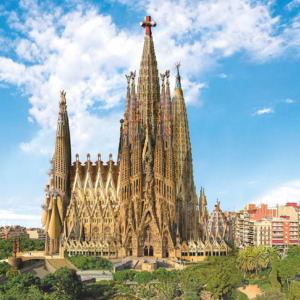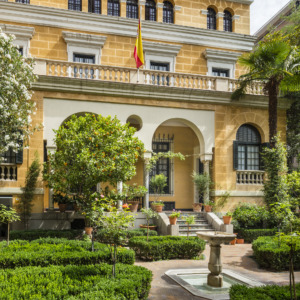The Fallas: Celebrating Spring in Valencia
“Discover all that Valencia has to offer, including its most emblematic festivals, such as the Fallas”
The Fallas festival was born to honor the arrival of spring by burning away all that is old. Today, it has become a monumental celebration that brings the city to a standstill for days and welcomes thousands of visitors ready to experience the most intense emotions. The festival is lived in the streets, outdoors under the stars or in the square under an intense sun, amidst continuous crowds of thousands of people.
The Fallas, with an official program that begins on March 1st and ends on the 19th, are like invocations to the presence of the all-powerful Sun so that its heat and light may fertilize the products of the earth. This fire is populated with figures, resembling trees, which benefit from this heat to transform into something new. This ritual represents a victory over death and an affirmation of the new life that the spring warmth produces in nature.
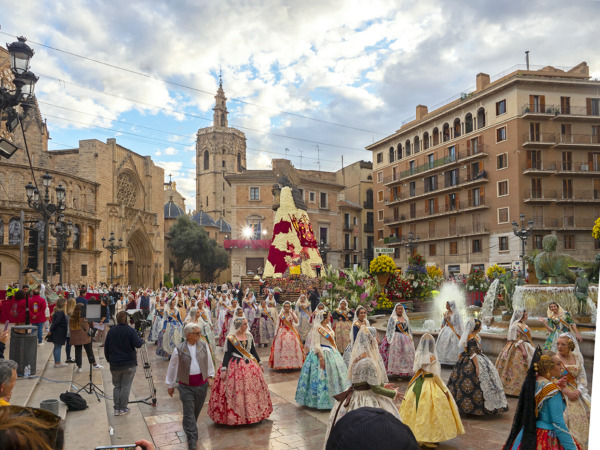
The monument called “falla” always has a story to tell, distributed in scenes, written on explanatory posters, and also in the “llibret,” a written catalog of the falla’s content. The chosen themes remain faithful to the tradition of the satyrs, rural deities of the retinue of the god Dionysus, who praised eroticism in their verses. In addition to this line of coarse humor, the falleros strive deeply to criticize the city, the neighborhood, the political life, the social customs. In reality, they exercise free criticism for a few days and then, after the redeeming fire, they accept the established order more willingly.
It is a very participative festival because the budget to build the monument and develop the program of events comes from voluntary contributions from the neighborhood, except for the falla of the Town Hall square, which is financed with the municipal budget. The fallas committees, of which there are more than four hundred in the city alone, mobilize thousands of people who dress in regional costumes and parade in processions accompanied by band music. It is, therefore, not only participative for the visitor but especially for the neighbors who practice festive associationism all year round. Each committee has its falleras mayores, president, treasurer, and other responsible persons for the complex organization of the festival.
The monuments, destined to disappear with the fire, are the result of the work of the whole year. The guild of fallas artists constitutes the permanent workforce of this craft activity, which has become an industry that guarantees employment for many people. Pyrotechnics is also a craft and artistic tradition deeply rooted in this land. During the fallas days, the powder shows its most spectacular face. Until the fourteenth century, it was called Greek fire, leaving no doubt about its origin. Towns in the metropolitan area of Valencia, such as Bétera, Godella, and Moncada, have authentic family sagas that have made this activity an art and an industry.
Another activity that generates jobs is the making of the fallera and fallero costumes and the showy ornaments that women wear on their heads. With obvious reminiscences of the Iberian lady found in Elche, the Valencian woman reproduces on her head two lateral headpieces and a posterior one with golden combs.
Some fallas artists hide with a certain mystery the design and details of their monuments until the night of March 15th, when the large fallas, and one day earlier the children’s fallas, are erected in the street. The next morning, they are visited by a jury that determines the best ones in the different categories, according to the budget invested in their construction. The most monumental and generously budgeted fallas are classified in the special section.
Days before, at the ninot exhibition, an individual sculpture or sculptural group is chosen by popular vote to be pardoned this year from the fire and will join the collection of figures in the Fallas Museum for its artistic interest.
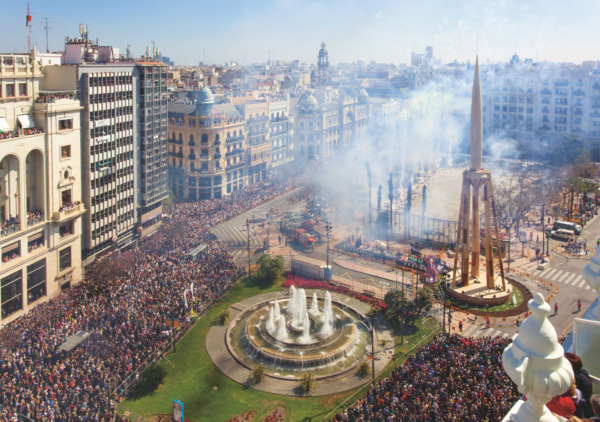
Vista des del cel de les Les Falles de Valencia
Between March 16th and 19th, Saint Joseph’s Day, numerous streets in the city are closed to traffic for the installation of the fallas monuments and the tents where the committee holds its social events. Luminous ornaments cover the pavement with vaults of surprising figures. The day begins with the “despertà”, episode in which the falleros wake up the neighborhood with firecrackers and music. Then, throughout the morning, numerous processions take place, as well as the collection of awards. At noon, between one and two o’clock, the mascletà is set off, a noisy spectacle that arouses passions. In the triangular square of the Town Hall, this detonation begins on March 1st. Thousands of people come at this time from their neighborhoods on foot to the main square of the city to tremble with the powder. It lasts about six minutes and is subject to various limitations set by the festival organizers: it is prohibited to exceed 115 decibels of acoustic impact and to burn more than 120 kilos of gunpowder.
Day and night, popular meals are offered at the falla clubhouses, the social headquarters of each committee, especially paellas cooked over fires lit in the street. In the afternoon of the 17th and 18th, the floral offering to the Virgin of the Forsaken takes place and there are festivities and contests, ending the day with fireworks displays. The Night of Fire is the great nocturnal event on March 18th in the old Turia riverbed. A spectacular fireworks display artificially illuminates the city with monumental bursts of color. Parties and concerts liven up the neighborhoods, producing a noise that prevents sleep until late at night.
And comes the end of the festival, the cremà, at midnight on March 19th. The burning of the fallas monument, among carcasses and multicolored bursts of powder, eliminates all traces of the festival. In a few hours, with the collaboration of the urban cleaning service and firefighters, there are no traces left in the city of these days of social extraversion. Once again, the cathartic destiny of all the effort of a year has been fulfilled, because the old gives way to the new that is yet to be born.
Don’t forget to explore all that Valencia has to offer, including its markets, parks, museums, and of course, the incredible Fallas. And if you’re interested in learning more about this fascinating city, you can find detailed information and tips in the book “Valencia Imprescindible” by Triangle Postals.
For more information and details about the wonders that Valencia has to offer, check out the book “Valencia Imprescindible” by Triangle Postals.

